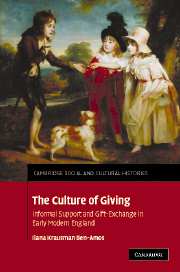Book contents
- Frontmatter
- Contents
- List of illustrations
- List of tables
- Acknowledgements
- List of abbreviations
- Introduction
- Part I Social spaces and reciprocities
- 1 Parents and offspring
- 2 Networks of support
- 3 Parishes, guilds and associations
- 4 The charitable gift
- Part II The economy of giving
- Part III The state, markets and gifts
- Conclusion
- Bibliography
- Index
3 - Parishes, guilds and associations
Published online by Cambridge University Press: 04 May 2010
- Frontmatter
- Contents
- List of illustrations
- List of tables
- Acknowledgements
- List of abbreviations
- Introduction
- Part I Social spaces and reciprocities
- 1 Parents and offspring
- 2 Networks of support
- 3 Parishes, guilds and associations
- 4 The charitable gift
- Part II The economy of giving
- Part III The state, markets and gifts
- Conclusion
- Bibliography
- Index
Summary
Many types of informal support were allocated within close-knit groups and corporate bodies that had long been a familiar presence in the countryside and towns. These social bodies – parishes and guilds – were based on a great deal of personal acquaintance and encounters of members in daily affairs and social gatherings, and their social orbit sometimes overlapped with social networks and neighbourly ties of the kind examined in the previous chapter. Yet, these bodies could also extend beyond ties of neighbourhood, encompassing persons of a more distant purview who were less intimately bound to one another, but who were linked together by virtue of their membership of the group. Already in late medieval times, parish activities increasingly centred not only on church services or the collection of tithe, but also on social obligations – maintaining order, repairing roads and looking after the sick and the aged – that reached beyond one's immediate pale of relations and more intimate networks of care. By the late fifteenth century, many parishes had gradually built up a stock of land and distributed the residue of their income for the church's maintenance to charity and the poor. Bread, grains and clothes were routinely distributed by church officials to those in need on Sundays, Christmas, Lent, Easter week and Whitsunday. Other mechanisms for offering support existed, such as charity ales organized periodically to raise money for newlyweds and members of the parish who had fallen on hard times.
- Type
- Chapter
- Information
- The Culture of GivingInformal Support and Gift-Exchange in Early Modern England, pp. 82 - 112Publisher: Cambridge University PressPrint publication year: 2008



